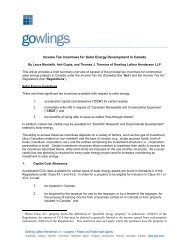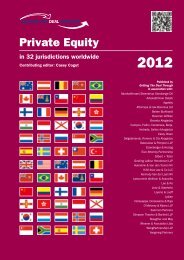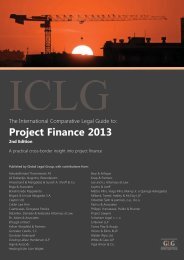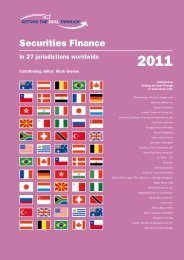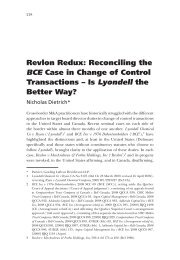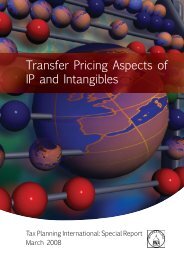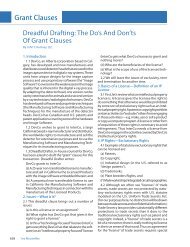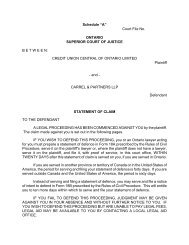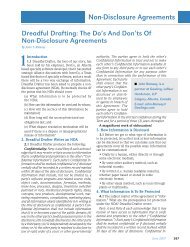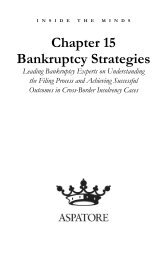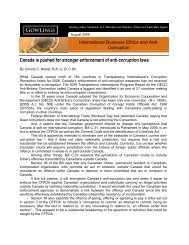RESTRICTIVE COVENANTS IN EMPLOYMENT ... - Gowlings
RESTRICTIVE COVENANTS IN EMPLOYMENT ... - Gowlings
RESTRICTIVE COVENANTS IN EMPLOYMENT ... - Gowlings
You also want an ePaper? Increase the reach of your titles
YUMPU automatically turns print PDFs into web optimized ePapers that Google loves.
I. <strong>IN</strong>TRODUCTION<br />
<strong>RESTRICTIVE</strong> <strong>COVENANTS</strong> <strong>IN</strong> <strong>EMPLOYMENT</strong> <br />
RELATIONSHIPS – HOW TO PROTECT YOUR BUS<strong>IN</strong>ESS <br />
FROM DEPART<strong>IN</strong>G EMPLOYEES <br />
Karen A. Hamway and Heather A. Wilson 1<br />
It is generally undisputed that in order for employers to minimize unfair<br />
competition by departing and former employees, it is necessary that the employees’<br />
post-employment activities be subject to certain restrictions. However, for the most<br />
part, it is also recognized that former employees still need to be able to earn a living.<br />
Therefore, they need to be as free as possible to compete with their former employers<br />
in order to cultivate new employment opportunities. The Supreme Court of Canada<br />
recognized, as early as 1935, that, “public policy…requires on the one hand that<br />
employers be free to protect from violation their property rights in business, and on the<br />
other hand, that every man be left free to use to his advantage his skill and knowledge<br />
in the trade.” 2<br />
The delicate balance of these two positions takes its shape in the<br />
continuing debate over the enforceability of restrictive covenants in employment<br />
agreements.<br />
It has been repeatedly stated by judges that restrictive covenants are considered<br />
to be generally undesirable because they restrict democratic principles of free trade,<br />
that is, they are in restraint of trade. The question then arises as to how an employer<br />
1 Karen A. Hamway is a partner practising in employment law in the <strong>Gowlings</strong>’ Ottawa office. Heather A.<br />
Wilson is an associate also practising in the employment law group. <br />
2 Maguire v. Northland Drug Co., [1935] S.C.R. 412 at 3.<br />
1
can protect his or her proprietary interests in the secret client lists, pricing and profit<br />
margins and client relationships, among other unique assets, from being used to unfairly<br />
compete by a former employee. The purpose of this paper is to provide an overview of<br />
restrictive covenants in the employment context, address the challenges with respect to<br />
enforceability, and illustrate how to overcome these challenges in order to draft a<br />
restrictive covenant that is most likely to be found enforceable in the event that it must<br />
brought before the Courts for examination.<br />
II.<br />
WHAT IS A <strong>RESTRICTIVE</strong> COVENANT<br />
A restrictive covenant is generally found in an employment agreement. They<br />
may also be a term in a contract for the sale of a business but the law treats these latter<br />
restrictive covenants somewhat differently so they will not be the subject of this<br />
discussion. The covenant is an express term between an employer and employee<br />
which attempts to limit the competitive activities of the employee during or after the<br />
employment relationship ends for a specific period of time in a specific geographic area.<br />
The purpose of the covenant is to protect the good will and proprietary interests of the<br />
employer from exploitation by the former employee. Proprietary interests include, but<br />
are not limited to: client lists, customer and employee relationships, confidential<br />
information and trade secrets of the employer. In the case of employees, the courts<br />
guard carefully an employee’s right to be able to use his or her acquired skills and<br />
general business knowledge to continue to earn a livelihood especially in view of the<br />
imbalance of power between employee and employer. On the other hand, employees<br />
often must be trusted with information and client relationships that are so essential to<br />
2
the employer’s business that appropriate restrictive covenants are essential to the<br />
longevity of the employer’s business.<br />
III.<br />
TYPES OF <strong>RESTRICTIVE</strong> <strong>COVENANTS</strong><br />
There are three primary types of restrictive covenants: non-competition; nonsolicitation;<br />
and confidentiality/non-disclosure clauses. Each of these three covenants<br />
are drafted with the intent of restricting a different type of competition, activity, or<br />
behaviour.<br />
1. Non-Competition Clause<br />
A non-competition clause attempts to prohibit a former employee from starting up<br />
his or her own business, or from accepting employment, in competition with the former<br />
employer for a specific period of time in a specific geographic location.<br />
A<br />
non-competition clause is considered to be the most onerous of the three restrictive<br />
covenants and, accordingly, is the least likely restrictive covenant to be enforced by the<br />
Courts.<br />
2. Non-Solicitation Clause<br />
A non-solicitation clause provides that a departing employee may not solicit<br />
employees, suppliers, or customers of the former employer, within a specific area, for a<br />
specific period of time after the employment relationship ends. The purpose of the<br />
non-solicitation agreement is to prevent a former employee from taking advantage of<br />
the intimate and influential relationships he or she developed with employees and<br />
3
customers, in the course of their employment. The concern is that these pre-existing<br />
relationships obtained in the service of the business will then be used by departing<br />
employees to solicit employees and customers away from the business. The nonsolicitation<br />
clause is designed to provide the employer with sufficient time to put a new<br />
employee in place to connect and build relationships with remaining employees and<br />
customers. 3<br />
3. Confidentiality Clause<br />
A confidentiality or non-disclosure clause is drafted to prevent a former employee<br />
from disclosing, or using, confidential information, such as the manner in which the<br />
business is carried out, the identity of suppliers, pricing structure, market plans, product<br />
development, manufacturing processes, or customer lists, for their own purposes or<br />
those of a competitor. Although employers are generally protected at common law<br />
against the disclosure of confidential information, a confidentiality or non-disclosure<br />
clause included in an employment agreement provides additional assurances that the<br />
information will remain confidential.<br />
IV.<br />
ENFORCEABILITY<br />
As a general rule, restrictive covenants in the employment context are<br />
considered to be a restraint on trade and, therefore, contrary to public policy. As a<br />
result, restrictive covenants in employment agreements are deemed to be prima facie<br />
void and unenforceable. However, as with most rules, there are exceptions made by<br />
3 Phytoderm Inc. v. Urwin, [1999] O.J. No. 383 at para 14 (O.C.J. (Gen.Div.)).<br />
4
the Courts to protect businesses from unfair competition by departing employees. The<br />
leading case in Canada, with respect to restrictive covenants is Elsley v. J.G. Collins<br />
Insurance Agencies Ltd., 4<br />
which sets out the principles to be considered when<br />
determining if a covenant is enforceable:<br />
The principles to be applied in considering restrictive<br />
covenants of employment are well established…A covenant<br />
in restraint of trade is enforceable only if it is reasonable<br />
between the parties and with reference to pubic interest. As<br />
in many of the cases which come before the courts,<br />
competing demands must be weighed. There is an<br />
important public interest in discouraging restraints on trade,<br />
and maintaining free and open competition unencumbered<br />
by the fetters of restrictive covenants. On the other hand,<br />
the courts have been disinclined to restrict the right to<br />
contract, particularly when that right has been exercised by<br />
knowledgeable persons of equal bargaining power. 5<br />
The Supreme Court went on to say that when conducting an assessment of<br />
these conflicting principles, to determine if a restrictive covenant should be enforced,<br />
the assessment is whether the terms of the covenant are reasonable in the<br />
circumstances. Reasonableness, the Court opined, could only be determined upon an<br />
overall assessment, of the clause, the agreement within which it is found, and all of the<br />
surrounding circumstances.<br />
In order to determine if a covenant is reasonable, the Supreme Court set out<br />
three important questions to be asked within the facts of each case:<br />
4<br />
Elsley v. J.G. Collins Insurance Agencies Ltd., [1978] 2 S.C.R. 916 [“Elsley”].<br />
5<br />
Ibid at 5.<br />
5
1. Does the employer have a proprietary interest entitled<br />
to protection as opposed to something that is<br />
generally available in the industry<br />
2. Are the territorial boundaries or temporal features of<br />
the clause unnecessarily broad as to be considered<br />
unreasonable for the purpose of protecting the<br />
proprietary interest<br />
3. Does the covenant attempt to restrict competition<br />
generally or is it reasonable to achieve protecting the<br />
proprietary interest in the particular business<br />
context 6<br />
4. Is the covenant contrary to public policy<br />
1. Proprietary Interests<br />
According to the Supreme Court’s analysis in Elsley, one of the first factors to<br />
consider when determining if a covenant is reasonable is whether or not the employer<br />
has a legitimate proprietary interest, which he or she is entitled to protect. Proprietary<br />
rights include confidential or secret information with respect to manufacturing<br />
processes, merchandising, and customer information, such as customers’ names,<br />
addresses, tastes and desires. However, the general business information and training,<br />
which an employer imparts to his or her employee, is not considered to be proprietary<br />
information, particularly if it is generally available in the industry. This skill and<br />
knowledge becomes a part of the employee and is beyond the reach of a restrictive<br />
covenant since the employer can have no proprietary interest in it. 7<br />
6<br />
Ibid at 5 and 6.<br />
7<br />
Supra note 1 at 3.<br />
6
2. Temporal and Spatial Limits<br />
a) Spatial /Geographic<br />
Another important factor, in determining if a restrictive covenant is reasonable, is<br />
the spatial/geographic restriction contained in the covenant. The geographic restriction<br />
prohibits a former employee from accepting similar employment, establishing a<br />
competitive business, or soliciting former customers, within a specific geographic area.<br />
If the geographic region is wider than reasonably necessary to protect the employer’s<br />
legitimate proprietary interests, the covenant will not be enforceable. The restriction<br />
should reflect the geographic areas in which the employee had involvement during the<br />
course of his or her employment. It would be unreasonable to have a geographic<br />
restriction that extends beyond the area where the employee did business. When<br />
determining what the permissible geographic scope of a restraint should be, the Court<br />
will look to the reasonable and mutual expectations of the parties at the time of making<br />
the contract 8 . Regardless or the breadth of the geographic area, the area must be<br />
clearly defined in the agreement, in other words, it cannot be global to be enforceable.<br />
b) Temporal<br />
The purpose of a temporal restriction, in a restrictive covenant, is to allow a<br />
reasonable time for the employer to adjust to the employee’s departure and take the<br />
necessary steps to ensure that employee and customer relationships are re-established<br />
8<br />
Tank Lining Corp. v. Dunlop Industrial Ltd. (1982), 68 C.P.R. (2d) 162 (Ont.C.A.).<br />
7
y a new employee. At the same time this affords the employer time for the bonds<br />
between the former employee, colleagues, and clients to diminish reducing the risk that<br />
the former employee will be able to leverage these relationships to the employer’s<br />
detriment. Should this period of time be longer in duration than is reasonably necessary<br />
for the employer to accomplish these goals, the Courts will not enforce the covenant.<br />
While the duration of the restrictive covenant may vary based on the circumstances,<br />
most covenants specify a period of about one year from the date the employment<br />
ended.<br />
3. Non-competition versus Non-solicitation Clauses<br />
The Supreme Court in Elsley, also stated that when determining if a restrictive<br />
covenant is reasonable there should be an examination as to whether it is necessary to<br />
utilize the more onerous non-competition clause, or whether a non-solicitation clause<br />
would be sufficient to protect the employer’s proprietary interests.<br />
As stated previously, since non-competition clauses are the most onerous type of<br />
restrictive covenant, they tend to be the most difficult to enforce. There is a common law<br />
presumption that non-competition clauses are unenforceable and the onus to prove that<br />
the covenant is reasonable, and therefore enforceable, rests upon the employer. A<br />
non-competition clause will only be upheld if the employer can prove that the nature of<br />
the employment was such that customers will have either learned to rely upon the skill<br />
or judgment of the former employee or dealt with him or her directly and personally to<br />
the virtual exclusion of the employer. When such an employee has become “key” to all<br />
8
or part of the business, he or she will probably readily gain their customers, if he or she<br />
sets up their own business or changes employment to a competitor. 9<br />
Such unfair advantage gained through the trust relationship with the former<br />
employer is the proper subject on non-competition and non-solicitation clauses.<br />
The Ontario Court of Appeal, in Lyons v. Multari, 10 stated that Courts would not<br />
enforce a non-competition clause where a non-solicitation clause would adequately<br />
protect the employer’s legitimate business interests. A non-competition clause may be<br />
considered overly broad as it does more than just protect the employer’s customer<br />
base; it attempts to keep the former employee out of business. In order to determine if<br />
a non-solicitation clause is sufficient there must be a consideration of the nature of the<br />
employer’s business and the nature of the former employee’s role in the business. Only<br />
in exceptional circumstances will the nature of the employment justify a covenant<br />
restricting an employee, not only from soliciting customers, but also from working for a<br />
competitor or establishing his or her own business in the geographical vicinity.<br />
More recently, the Ontario Court of Appeal, in IT/NET v. Cameron, 11 has further<br />
established that where a non-solicitation clause is unreasonable it will not be<br />
enforceable. In this matter, the Plaintiff, IT/NET, offered information management<br />
services to various departments of the federal government. The plaintiff had a contract<br />
to provide services to the Department of National Defence and contracted with the<br />
9<br />
Supra note 3 at 7. <br />
10<br />
Lyons v. Multari, [2001] 50 O.R. (3d) 526 (C.A.). <br />
11<br />
IT/NET v. Cameron, [2006] O.J. 156 (C.A.). <br />
9
defendant, Cameron, to provide those services. The contract included a noncompetition,<br />
non-solicitation, and confidentiality clause. When the position was reposted,<br />
the defendant allowed a competitor of the plaintiff to submit a bid for the<br />
contract that included his resume. The competitor was successful, the plaintiff lost the<br />
bid, and the defendant remained in the position. The plaintiff then sued for breach of<br />
contract.<br />
The Court of Appeal found the provisions were unenforceable. The nonsolicitation<br />
clause prevented the defendant from soliciting business from any IT/NET<br />
client or prospect, not just from the client where the defendant was placed. As a result<br />
of this decision, restrictive covenants that prohibit former employees from soliciting all<br />
customers of the employer, rather than just those with whom the former employee had<br />
relationships, will be found unenforceable. The restriction ought to be limited to<br />
customers with whom the employee has had direct contact.<br />
4. Additional Factors: Public Interest and Balance of Power<br />
Once the party relying on the restrictive covenants has established that it is<br />
reasonable as between the parties, the onus on proving that it is contrary to public<br />
interest shifts to the person attacking the validity of the covenant. For example, a<br />
restrictive covenant, which barred an obstetrician from practicing any form of medicine<br />
or surgery within five miles of St. Catharines, Ontario was found to be enforceable.<br />
However, the obstetrician was able to demonstrate that, although the covenant was<br />
reasonable, it was contrary to public interest. The evidence showed there was a<br />
10
shortage of obstetricians in that area and as many doctors as possible should be made<br />
available. As a result, the restrictive covenant was struck down. 12<br />
a) Power Imbalance<br />
The Courts will consider the balance of power between the parties when the<br />
restrictive covenant was negotiated. The Courts recognize that an employee has a<br />
disproportionate amount of power when entering into agreements with their employer.<br />
Frequently, if the employee does not agree to the restrictive covenant they will not be<br />
hired for a particular position or their employment may be terminated. As a result, the<br />
greater the disparity in bargaining power, the less likely the Court will be to uphold the<br />
covenant. 13<br />
However, generally speaking, although employees are at the less powerful<br />
end of the spectrum, they can develop the power to destroy an employer’s business<br />
upon departure and the Courts have been sympathetic to employers in those<br />
circumstances.<br />
V. SHIFT<strong>IN</strong>G OBLIGATIONS<br />
A recent decision by the British Columbia Court of Appeal has suggested a<br />
potential shift in how the Courts will view a businesses’ claim of confidentiality over<br />
client lists and information. Diverging from the case law, in early 2007, the Court of<br />
Appeal, in RBC Dominion Securities Inc. v. Merrill Lynch Canada Inc., held that there is<br />
no obligation on a departing employee to refrain from competing with their former<br />
12<br />
Sherk v. Horwitz, [1972] 2 O.R. 451 (H.C.).<br />
13<br />
Supra note 7.<br />
11
employer and there is no breach of confidence when an employee takes with him or her<br />
lists of names, addresses, telephone numbers, and his or her “book of business”.<br />
The issue arose when a group of investment advisors, assistants, and the branch<br />
manager left their employment with RBC and joined Merrill Lynch, without any notice of<br />
the move to RBC. Prior to their departure, the group took confidential client information<br />
to Merrill Lynch to be copied for their use once they left RBC. As a result, they were<br />
able to continue their business with clients they met while at RBC. The trial judge held<br />
that the planned departure, lack of notice of departure, and the use of confidential<br />
information resulted in award of lost profits in the amount of 1.7 million dollars over the<br />
five years since the departure and punitive damages the amount of $300,000.00.<br />
Surprisingly, the Court of Appeal reduced the award for lost profits to $40,000.00,<br />
representing only the two and a half week period of notice the employees should have<br />
provided to RBC. The punitive damage award remained the same. The majority held<br />
that while advisors do owe a duty of confidentiality not to misuse client information, the<br />
best interests of the clients must be considered when determining what client<br />
information is confidential. Due to the confidential nature of the relationship between a<br />
client and their advisor, clients should be able to be made immediately aware of an<br />
advisor’s departure in order to decide if they would like to follow the advisor to their new<br />
place of business. The Court found that a rule preventing advisors from taking client<br />
lists with them is not in the “public interest” because of the detrimental effect on<br />
investors It was critical to this decision that RBC, a sophisticated client, chose not to<br />
obtain non-competition, non-solicitation agreements from their advisors. However, it is<br />
12
a real possibility that even if non-competition or non-solicitation agreements had been<br />
included in the employment agreement, the Court may have found the restriction<br />
contrary to “public interest” and, therefore, unenforceable in any event.<br />
There has been some suggestion that the decision may be limited in application<br />
to brokerages and investment advisors as the Court of Appeal specifically stated that<br />
the brokerage industry was different from many other industries in that advisors develop<br />
a special relationship of confidence and trust with their clients and that it can be of the<br />
utmost importance to clients that there is no break in service from the advice provided to<br />
them by their advisors. While this case may represent an unsettling shift in law, the<br />
impact remains to be seen, as leave to appeal to the Supreme Court of Canada has<br />
been sought in this case.<br />
VI. ENFORCEABILITY OF A <strong>RESTRICTIVE</strong> COVENANT <strong>IN</strong> THE EVENT OF AN<br />
EMPLOYER’S BREACH OF CONTRACT<br />
Employers frequently inquire as to the enforceability of a restrictive covenant<br />
where an employee has claimed that the employer breached the contract by way of a<br />
constructive or wrongful dismissal. Generally, if an employer is found to have<br />
constructively or wrongfully dismissed the employee, thereby, breaching the<br />
employment agreement, the employer will be prohibited from relying upon a restrictive<br />
covenant in the agreement.<br />
The earliest case in this regard appears to be General Billposting Co. v.<br />
13
Atkinson. 14 The plaintiff’s employment agreement provided that he was to receive 12<br />
months notice of termination. However, despite the agreement, the plaintiff was<br />
terminated without notice. The plaintiff took the position that the restrictive covenant<br />
was not enforceable. The Court stated that:<br />
Where… a servant is wrongfully discharged without notice,<br />
he may elect to treat the contract as completely at an end,<br />
retaining his right to bring an action for the breach, and is no<br />
longer bound by a clause in the contract restrictive of his<br />
right to trade on the termination of his engagement. 15<br />
The decision in Billposting was upheld nearly 100 years later in the matter of<br />
Gerrard v. Century 21 Armour Real Estate Inc. 16<br />
The plaintiff, Ms. Gerrard, was<br />
employed as a sales manager for the defendant, Century 21. Upon hire, Ms. Gerrard<br />
had signed an employment agreement, which contained a non-competition and nonsolicitation<br />
clause. After some time, Century 21 requested that Ms. Gerrard accept a<br />
reduction in salary, which she refused. Ms Gerrard then commenced an action for<br />
constructive dismissal and a declaration that her employment agreement and restrictive<br />
covenants were no longer in force. Ms. Gerrard also proceeded to open a new office in<br />
competition with Century 21 and hired four of their employees.<br />
Century 21 brought a motion for an interlocutory injunction to enforce the<br />
restrictive covenants. Justice Feldman stated that the question was whether the<br />
conduct of Century 21 demonstrated an intention to no longer be bound by the contract,<br />
14<br />
General Billposting Co. v. Atkinson, [1909] A.C. 118 (H.L.) [“Billposting”].<br />
15<br />
Ibid at . <br />
16<br />
Gerrard v. Century 21 Armour Real Estate Inc. (1991), 4 O.R. (3d) 191 (Gen.Div.). <br />
14
as once it is established that an employment agreement has been rescinded, any<br />
restrictive covenant contained within it will fall. On that basis, Justice Feldman held that<br />
it would be unjust at an interlocutory stage (as it was not yet clear if the agreement had<br />
been rescinded) to enforce the terms of the agreement against Ms. Gerrard when<br />
Century 21 was not prepared to continue to be bound by the terms of the agreement.<br />
In a series of similar cases Psenica v. Dee-Zee Construction Ltd., 17 MacDonald<br />
Ohm Insurance Brokers Ltd. v. Gilmore, 18 and Telehop Communications v. Abbott, 19 the<br />
Courts continued to conclude that:<br />
More specifically that:<br />
It has been held that if the employer has breached the terms<br />
of the contract by wrongfully dismissing the employee, the<br />
employer is not entitled to enforce the restrictive<br />
covenant…if the employer breaches the agreement he can<br />
no longer expect the employee to be bound by the very<br />
agreement which he has breached. 20<br />
…constructive dismissal amounts to a repudiation of an<br />
employment contract, discharging the employee from future<br />
obligations under the contract. 21<br />
The 2006 decision of Mick v. Boulder City Climbing School Inc. 22 , once again,<br />
followed the reasoning of the above-noted decisions. In Mick, the plaintiff was the<br />
director of operations, president, and sole directing mind of the defendant’s rock<br />
climbing company. The plaintiff’s employment agreement contained a non-competition<br />
17<br />
Psenica v. Dee-Zee Construction Ltd., [1999] S.J. No. 749 (Sask.Q.B.). <br />
18<br />
MacDonald Ohm Insurance Brokers Ltd. v. Gilmore, [2000] O.J. No. 2745 (O.S.C.J.). <br />
19<br />
Telehop Communications v. Abbott, [2002] O.J. No. 1780 (O.S.C.J.). <br />
20<br />
Supra note 16 at para. 23.<br />
21<br />
Supra note 18 at para. 8. <br />
22<br />
Mick v. Boulder City Climbing School Inc., [2006] O.J. No. 2528 (O.S.C.J.) [“Mick”]. <br />
15
and non-solicitation clause. The defendant failed to pay the plaintiff’s salary for two pay<br />
periods and the plaintiff advised the defendant that he considered the agreement to<br />
have been breached and the restrictive covenants no longer enforceable. The plaintiff<br />
then decided to open his own rock climbing business.<br />
The Court agreed with the<br />
plaintiff and held that the plaintiff’s position was “both reasonable and legally sound” and<br />
he was no longer bound by the restrictive covenants in his employment agreement.<br />
There are cases where an employer has attempted to draft restrictive covenants,<br />
which state that the covenant is to remain enforceable even in the event of a wrongful<br />
dismissal. Such a claim was made in Raymond Salons Ltd. v. Boucher. 23 Surprisingly,<br />
the Court found in favour of the employer. The Court stated that based upon the<br />
wording of the covenant, it was enforceable even though the employer had breached<br />
the employment agreement. However, it has been noted that the employee’s counter<br />
claim, alleging the wrongful dismissal, had not yet been decided and the decision made<br />
no reference to General Billposting or any other relevant cases. 24<br />
More in line with the Court’s usual position on these issues is the decision in<br />
Jostens Canada Ltd. v. Zbieranek . 25<br />
The employment agreement in this case stated:<br />
…during the term of this Agreement and for a full and<br />
continuous period of one year after this Contract is breached<br />
or terminated by either party, regardless of the reasons,<br />
he or she will not directly or indirectly, for himself or herself<br />
23<br />
Raymond Salons Ltd. v. Boucher (1990), 29 C.P.R. (3d) 58 (B.C.S.C.).<br />
24<br />
G.K. Steele & K. Thornicroft, Employment Contracts and Confidential Information (Markham:<br />
Butterworths Canada Ltd., 2002) at 133.<br />
25<br />
Jostens Canada Ltd. v. Zbieranek (1992), 42 C.P.R. (3d) 519 (Ont.Gen.Div).<br />
16
or for any other person…solicit, sell, promote or assist on the<br />
solicitation…of school photography [emphasis added] 26<br />
The Court refused to accept the validity of a restrictive covenant that expressly<br />
provided that in the event of a wrongful dismissal an employee would remain bound by<br />
the decision. The Judge stated:<br />
In my view, there is some doubt as to the efficacy of a term<br />
in the employment contract contemplating a ban on post<br />
employment competition when it purports to be effective no<br />
matter what reason the contract is terminated. 27<br />
As a result, it is unlikely that, even if an employer does draft a restrictive<br />
covenant with language intended to protect the covenant’s enforceability in the event of<br />
a wrongful or constructive dismissal, the Courts will permit the covenant to stand.<br />
VII.<br />
DRAFT<strong>IN</strong>G<br />
Drafting a valid and enforceable restrictive covenant requires an understanding<br />
of the legal principles and the employer’s business context. If the restrictive covenant is<br />
unreasonably broad, it will not be enforceable. On the other hand, if the covenant is not<br />
broad enough, it will not provide any significant protection for the employer.<br />
Furthermore, the covenant must be drafted using clear and precise language, as any<br />
ambiguity in the drafting will be interpreted against the employer.<br />
26<br />
Ibid at para. 4.<br />
27<br />
Ibid at para. 35.<br />
17
1. Reading Down<br />
It is not uncommon, in both the employment and business context, that in an<br />
attempt to avoid having their restrictive covenants found to be overly broad, that<br />
employers or purchasers will draft clauses that set out decreasingly restrictive<br />
geographic zones or time periods. The covenant specifies that if the more restrictive<br />
geographic zone or time period is struck down, the less restrictive place or time should<br />
stand. While the Court has the power to interpret an otherwise valid restrictive<br />
covenant, the Court will not “read down” an overbroad covenant in order to render it<br />
enforceable. 28<br />
This principle was stated by the Court in Canadian Financial Corp.<br />
(Can.) v. King:<br />
It is no function of the courts to act as de facto arbitrators<br />
over clauses that are drawn as alternatives. If the covenant<br />
says that the employee will not compete in (a) Canada, (b)<br />
British Columbia, and (c) Vancouver, for (i) ten years, (ii) five<br />
years, and (iii) one year, for example, the courts ought not to<br />
use the ‘blue pencil’ rule to make an agreement for the<br />
parties that they have been unable to make for themselves.<br />
Such a clause, where one alternative encompasses another,<br />
but on a wider scale, is, in my opinion, void for uncertainty<br />
and should not be made valid by severance. The only point<br />
on which the terms of the covenant are clear is that the<br />
covenant is to cover at least Vancouver for at least one year.<br />
The parties could have said that if they failed then they will<br />
risk losing the whole clause. 29<br />
Consequently, employers should be sure to draft covenants that precisely and<br />
accurately reflect the group of employees or customers that may not be solicited, as<br />
28<br />
Canadian Financial Corp. (Can.) v. King (1989), 23 B.C.L.R. (2d) 257 at 268 (C.A. ).<br />
29<br />
Ibid at 11.<br />
18
well as the length of time necessary for them to re-establish relationships with<br />
customers, as the Court will not, in an “either/or” situation, make decisions to create an<br />
agreement that the parties could not reach to themselves.<br />
2. Severability<br />
Should a portion of a restrictive covenant be found unenforceable, the Courts can<br />
decide to sever the offending portion. In order to sever a portion of the restrictive<br />
covenant, the offending clauses that are to be removed must not affect the meaning of<br />
the remaining contractual promise. The offending portions must only affect the extent of<br />
the promise. Furthermore, the remaining severed obligations must be a sensible and<br />
reasonable restriction and one that the parties would have unquestionably agreed to<br />
themselves without changing the terms of their initial agreement. Finally, and perhaps<br />
most importantly, the clause to be severed must be a separate and independent<br />
covenant. 30<br />
The importance of having specific restrictions drafted independently of one<br />
another was demonstrated in Orlan Karigan & Associates Ltd. v. Hoffman. 31<br />
In Orlan,<br />
Justice Juriansz was faced with a situation where the non-competition and nonsolicitation<br />
covenants were both part of the same paragraph. The former employee,<br />
Hoffman, argued that since the non-competition and non-solicitation provisions were<br />
contained in the same paragraph, it was not possible for the non-competition portion of<br />
30<br />
Supra note 32 at 10. <br />
31<br />
Orlan Karigan & Associates Ltd. v. Hoffman, [2001] O.J. 442 at para 28 (S.C.J.) [“Orlan”]. <br />
19
the paragraph to be found void and the remainder of the paragraph, the non-solicitation<br />
clause, to be enforceable. The plaintiff argued that the non-solicitation clause was<br />
enforceable as the agreement between the parties stated, “the invalidity of any provision<br />
in whole or in part shall not affect the validity of any other provision.” Nonetheless, the<br />
Court agreed with the defendant and held that the remaining non-solicitation clause was<br />
unclear and, moreover, since it was not contained in a separate paragraph which could<br />
be severed intact from the offensive non-competition covenants, the entire paragraph<br />
was unenforceable.<br />
VIII.<br />
IMPLEMENTATION OF <strong>RESTRICTIVE</strong> <strong>COVENANTS</strong><br />
1. Implementing Restrictive Covenants Post Hire<br />
Restrictive covenants should be implemented into the employment agreement at<br />
the time the agreement is first being negotiated, in which case the consideration<br />
necessary for the restrictive covenant is the employment itself. Should an employer<br />
attempt to implement a restrictive covenant post-hire, the employer must offer an<br />
additional form of consideration, such as a lump sum payment, increase in salary or<br />
promotion, in order for there to be proper consideration for the new covenant in the<br />
employment agreement. Despite a lump sum payment or salary increase, this<br />
additional consideration may still not provide any real incentive for an employee to<br />
agree to be bound by a restrictive covenant.<br />
In the event the employee elects not to agree to the terms of the restrictive<br />
covenant post-hire, the employer is limited in his or her options. Upon refusal, the<br />
20
employer may continue the employment relationship under the current agreement and<br />
not pursue the matter any further. Alternatively, the employer may continue to request<br />
that the employee agree to a restrictive covenant and increase the amount of<br />
consideration. As a last resort, the employer may require that the employee agree to be<br />
bound by a restrictive covenant, and if they will not, the employer may terminate the<br />
employee’s employment and provide him or her with proper notice of termination. 32<br />
The latter approach is unlikely to be practical or an effective business tool for obvious<br />
reasons.<br />
2. Hiring Employees Subject to Restrictive Covenants<br />
Employers need to make inquiries to determine whether a potential employee is<br />
subject to a restrictive covenant that could potentially limit the functions he or she could<br />
perform for the new employer. An employer who knowingly hires an employee who is<br />
subject to a restrictive covenant and induces the employee to breach the pre-existing<br />
covenant, could be found liable for damages to the former employer.<br />
By way of example, the matter of MacDonald (C.O.B. P&L Services) v. Klein, 33<br />
deals with the former employer, MacDonald’s, claim for intentional interference with<br />
contractual relations and conspiracy. The defendant, Klein, entered into a working<br />
relationship with MacDonald in the informatics consulting field. After a period of time,<br />
completely unknown to MacDonald, Klein entered into employment negotiations with<br />
32<br />
Supra note 23 at 97-99.<br />
33<br />
MacDonald (C.O.B. P&L Services v. Klein, [1998] O.J. No. 4922 (Gen.Div.).<br />
21
Sysnovators. Although aware of Klein’s obligations to MacDonald, Sysnovators worked<br />
with Klein to divert business away from MacDonald to Sysnovators. Klein also took<br />
copies of various business records, telephone lists, and consultants’ resumes. It was<br />
not until Klein had sufficient business in place with Sysnovators that he advised<br />
MacDonald he was leaving his employment. Klein did not provide MacDonald with any<br />
notice of his departure. As a result, it took MacDonald years to recover from the loss of<br />
Klein’s services.<br />
The Court stated that in order for MacDonald’s claim for damages to be<br />
successful, he had to prove that there was a valid and enforceable contract between<br />
MacDonald and Klein of which Sysnovators was aware, a breach of the contract was<br />
procured by Sysnovators, the breach of contract was effected through wrongful<br />
interference by Sysnovators and that MacDonald suffered damages as a result. To<br />
“procure” the breach of contract it was unnecessary for Sysnovators to specifically<br />
induce the breach. It would be sufficient if they disrupted or interfered with the<br />
contractual agreements between MacDonald and Klein.<br />
The Court found that all of these facts had been proved. Sysnovators and Klein<br />
were jointly and severally liable to pay MacDonald damages in the amount of<br />
$68,069.00.<br />
It would be prudent for employers to include a clause in the employment<br />
agreement stating that the employee has disclosed any and all restrictive covenants,<br />
and the details of the same, by which they are bound. The employer may also consider<br />
22
adding a clause which states that the employee agrees not to use any of his or her<br />
former employer’s proprietary information, in the course of their employment. In the<br />
event the employee is subject to a restrictive covenant, the employer should review the<br />
covenant to determine if the employee’s new position will be in violation of the<br />
covenant’s terms. If so, the new employer may consider approaching the former<br />
employer in an attempt to negotiate mutually agreeable parameters with respect to the<br />
employee’s new duties.<br />
3. Negotiating Restrictive Covenants Upon Termination of Employment<br />
Restrictive covenants may be included in a Release Agreement should a<br />
situation arise where a covenant was not implemented at the time of hire or during the<br />
course of employment. This is also an appropriate time for employers to review any<br />
existing restrictive covenants as they may also attempt to negotiate a new restrictive<br />
covenant into the Release Agreement should they recognize that the covenant currently<br />
in place is not enforceable. However, employers must be aware that there is no<br />
obligation for an employee to agree to a restrictive covenant upon termination. As with<br />
restrictive covenants proposed during the employment relationship, the employee does<br />
not have the same incentive to agree to the terms as they did at the time of hire.<br />
Consequently, an employer may decide to offer, in exchange for including the restrictive<br />
covenant in the Release Agreement, additional severance pay, outplacement<br />
23
counseling, or administrative support, to assist with the employee’s job search. 34<br />
IX.<br />
REMEDIES<br />
Once an employee or former employee breaches a restrictive covenant, the<br />
employer must decide what course of action to take. If the covenant does not expressly<br />
provide for a remedy in the event the covenant is breached, the employer or purchaser<br />
may make a claim for damages or injunctive relief.<br />
1. Damages<br />
Generally, when an employee or former employee breaches a restrictive<br />
covenant, the employer will be entitled to compensation by way of damages or an<br />
accounting of the offender’s profits. The employer or purchaser is not required to<br />
choose between a claim for damages or an accounting of profits, they are permitted to<br />
lead evidence with respect to both. At trial, it is the Judge who will determine what he or<br />
she believes is the appropriate amount of compensation to make the aggrieved party<br />
whole. 35 According to the Court in Moore International (Can.) Inc. Carter: 36<br />
…if their profit is greater than the loss by the former<br />
employer, an accounting is a better standard of<br />
compensation than damages. But, conversely, the employer<br />
should not be penalized for any business ineptitude of the<br />
fiduciary or his accomplice. So, if the loss by the employer is<br />
greater than the profit of the fiduciary, damages would be the<br />
better standard of compensation. It follows that, where the<br />
evidence will support a sound assessment based on an<br />
accounting of profits and also a sound assessment based on<br />
34<br />
Supra note 23 at 100-101.<br />
35<br />
Supra note 23 at 151. <br />
36<br />
Moore International (Can.) Inc. Carter (1984), 56 B.C.L.R. 207 (C.A.). <br />
24
a calculation of loss, and where, in the particular<br />
circumstances, both remedies are available and both are<br />
supported by the pleadings and the evidence, the<br />
compensation awarded should be the higher of the two. 37<br />
A claim for damages, rather than an accounting of profits, is based on the breach<br />
of contract. The assessment is, for the most part, based upon what the former<br />
employer has lost as a result of the breach of contract, rather than what the former<br />
employee has gained. In circumstances where it is not possible to identify the business<br />
opportunities that have been diverted, damages can be assessed by reference to the<br />
length of time intended by the restrictive covenant. 38<br />
Alternatively, an accounting of profits will occur when the former employee has<br />
diverted business away, either for his or her own benefit or that of his or her new<br />
employer. Any profits resulting from this diversion will be awarded to the former<br />
employer or purchaser. 39<br />
In J. & P. Gourmet House Ltd. v. Li 40 the Court decided to<br />
award damages based upon an accounting of profits. In this case, the defendant sold<br />
the majority of the shares in his company to the Plaintiff and remained on as a director<br />
and employee. Rather than working as directed, he started another company to<br />
compete with the purchaser of his shares and as a result, the plaintiff was awarded<br />
$95,000 for the profits recognized by the defendant.<br />
2. Injunctions<br />
37<br />
.Ibid at para. 23.<br />
38<br />
Supra note 23 at 151.<br />
39<br />
Ibid.<br />
40<br />
J. & P. Gourmet House Ltd. v. Li (1991), 39 C.P.R. (3d) 519, (B.C.S.C.).<br />
25
While a monetary award resulting from a breach of a restrictive covenant may<br />
compensate an employer financially, this award may not prevent ongoing harm if the<br />
offenders are free to continue to utilize confidential information or compete contrary to<br />
the restrictive covenant. As a result, employers can attempt to obtain an injunction.<br />
a) Interim Injunctions<br />
An interim injunction is an injunction that is issued by the Court prior to trial to<br />
prevent the former employee or his or her new employer, from continuing with their<br />
offending activity. The Court in Mark Anthony Group Inc. v. Vincor International Inc. 41 ,<br />
clearly sets out the purpose of the interim injunction:<br />
The purpose of an interlocutory injunction is not to prevent<br />
competition but to provide an equitable remedy designed to<br />
protect the parties pending a financial determination of a<br />
serious question. It is designed to prevent irreparable harm.<br />
It is a discretionary remedy. Whether it is granted or not is to<br />
be determined on a case by case basis with a view to<br />
providing a just and convenient result. 42<br />
The test as to whether or not an interim injunction should be granted was set out<br />
in RJR-MacDonald Inc. v. Canada (Attorney General) 43 as follows:<br />
• the applicant must demonstrate a serious question to be tried;<br />
41<br />
Mark Anthony Group Inc. v. Vincor International Inc., [1998] B.C.J. No. 2475 (C.A.).<br />
42 Ibid at para. 32.<br />
43<br />
RJR-MacDonald Inc. v. Canada (Attorney General), [1994] 1 S.C.R. 311.<br />
26
• the applicant is required to demonstrate that irreparable harm will result if the<br />
relief is not granted; and<br />
• the balance of convenience favours the applicant.<br />
While an interim injunction can usually be obtained quickly without conducting a<br />
full hearing on the merits of the claim, an employer or purchaser may be required to<br />
give an undertaking as to any damages that are sustained by the restrained party, if it<br />
turns out at a later date the injunction should not have been granted. 44<br />
b) Permanent Injunctions<br />
In circumstances where the former employee or vendor would not have been<br />
able to develop a new product or business without using confidential information which<br />
required them to breach a non-competition or non-solicitation clause, a former employer<br />
or purchaser may seek a permanent injunction. A permanent injunction will be granted<br />
on the basis that there is an ongoing obligation to a former employer or purchaser to<br />
refrain from competing using confidential information such as customer lists for the<br />
purpose of solicitation. The permanent injunction will only be granted if it is necessary<br />
to protect a legitimate business interest of the employer or purchaser. 45<br />
Permanent injunctions do not prohibit the former employee from ever competing<br />
with the former employer or purchaser. The injunction will only be in effect for as long<br />
as there is something to protect. The injunction may be limited to the amount of time it<br />
44<br />
Supra note 23. <br />
45<br />
Supra note 23 at 148-150.<br />
27
would have taken the former employee to develop the knowledge on his or her own,<br />
until the confidential information becomes public knowledge, or until the former<br />
employer has no interest in keeping the information confidential. 46<br />
In Compro Communications Inc. v. Communications Promo-Phone LT Inc., 47 the<br />
defendants, Communications Promo-Phone Ltd., contracted to sell their shares to the<br />
plaintiff. The sale agreement included a non-competition clause. Upon the sale of the<br />
shares, the defendant formed a new business to act in competition with the plaintiff and<br />
began preparing customer lists and using confidential information from the plaintiff in<br />
order to solicit the plaintiff's customers. As a result, the plaintiff sought a permanent<br />
injunction to restrain the unfair competition. The injunction was granted because the<br />
court found that the defendants were in breach of the agreement and of their fiduciary<br />
duty.<br />
X. CONCLUSION<br />
The delicate balance between an employer’s proprietary rights and a former<br />
employee’s right to compete and obtain new employment is very specific to each<br />
employment relationship and business context. Based upon the case law, restrictive<br />
covenants should be negotiated and entered into at the time the agreement is made,<br />
the restraint should be reasonable based upon the nature of the employee’s duties and<br />
relationships, and the geographic and temporal restrictions should be no broader than<br />
are absolutely necessary to protect the proprietary interests of the business. Restrictive<br />
46<br />
Supra note 23 at 148-150.<br />
47<br />
Compro Communications Inc. v. Communications Promo-Phone LT Inc. (1991), 41 C.P.R. (3d) 260 (Que. S.C.).<br />
28
covenants should be drafted using separate paragraphs to ensure that, should one<br />
provision be found unenforceable, it may be severed while keeping the remaining<br />
restrictions in force. Keeping in mind the following information and drafting clear,<br />
precise, reasonable covenants, there is an increased chance that the restrictive<br />
covenant will be found enforceable should it be reviewed by the Court.<br />
XI.<br />
PRACTICE TIPS<br />
When dealing with restrictive covenants, please keep in mind the following: 48<br />
• In the event that an employee signs an agreement containing a restrictive<br />
covenant after the employee accepts the offer of employment or commences<br />
work, ensure that adequate consideration is provided (e.g., salary increase,<br />
promotion, stock option, etc.).<br />
• Before hiring an employee, have the employee acknowledge that he or she is not<br />
subject to any restrictive covenants in favour of former employers. This may<br />
operate to limit the liability on claims by former employers alleging inducement of<br />
breach of contract or interference with contractual relations.<br />
• Ensure that the employment contract is kept current by responding to the<br />
passage of time as well as to any changes to the circumstances of the company<br />
or the employees.<br />
• Limit the scope, time, and geographic coverage of non-competition clauses to<br />
what is necessary and reasonable in the circumstances.<br />
• Ensure that non-disclosure, non-solicitation, and non-competition clauses are<br />
severable; that is, they appear in separate clauses and the employment contract<br />
contains a severability clause.<br />
• Use a non-solicitation clause instead of a non-competition clause if, as is usually<br />
the case, the former is sufficient to protect the company's interests.<br />
48<br />
W. Cascadden, C. Small, and H. Christie, Employment Issues Concerning Senior Managers and<br />
Executives (<strong>Gowlings</strong>, 2005).<br />
29
• When drafting a confidentiality or non-disclosure clause, expressly identify the<br />
information to be protected. This provides proof as to the type of information that<br />
the parties consider to be confidential.<br />
• Remember that Courts will review inequalities in bargaining power, the<br />
knowledge of the employee, the nature of employment, and the availability of<br />
other employment opportunities, as well as traditional factors such as the<br />
existence of independent legal advice.<br />
• Consider including contractual clauses setting out the methodology for<br />
calculating any damages claimed, or include a liquidated damages clause (that<br />
is, a clause naming a specific minimum dollar figure for which the employee will<br />
be liable in the event of a breach of the agreement).<br />
• In any clause dealing with the availability of injunctive relief, in addition to a<br />
statement to the effect that the employer will suffer irreparable harm,<br />
acknowledge that an injunction will not prevent the employee from earning a<br />
living.<br />
• Ensure that all restrictive covenants, damages clauses and injunctive relief<br />
clauses survive the termination of the employment contract and are enforceable<br />
notwithstanding the existence of any other claims of the employee.<br />
It is recommended that restrictive covenants in employment agreements be<br />
reviewed by legal counsel with expertise in employment law to avoid the potentially<br />
serious harm that can be done by departing employees.<br />
OTT_LAW\ 1536705\1<br />
30



